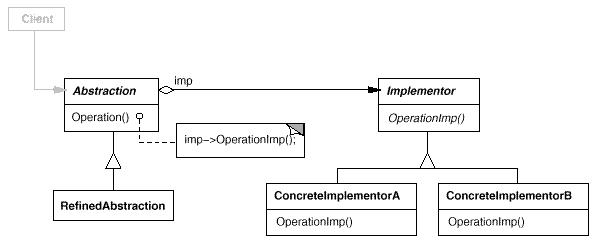This is the 4Th Arcticle: Builder PATTERN
Separates the construction of a complex object from its representation so that the same construction process can create different representations. --Gof
The builder pattern can separate the representation and construction easily , while you building a big-pang object , and some of the object itself is
diversified and could be build separately , considering this pattern.
Participants:
Builder.
- specifies an abstract interface for creating parts of a Product object
ConcreteBuilder.
- constructs and assembles parts of the product by implementing the Builder interface
- defines and keeps track of the representation it creates
- provides an interface for retrieving the product
Director.
- constructs an object using the Builder interface
Product.
- represents the complex object under construction. ConcreteBuilder builds the product's internal representation and defines the process by which it's assembled
- includes classes that define the constituent parts, including interfaces for assembling the parts into the final result
The diagram goes here:

Code is the most clearly lauguage for out programmers , so I will use code to expree this pattern clearly as follows:
1
2
 /**//* this is the diversfied part*/
/**//* this is the diversfied part*/
3
4 //abstract
//abstract
5 class House
class House
6

 {
{
7
8 };
};
9 //abstract
//abstract
10 class Door
class Door
11

 {
{
12
13 };
};
14
15 //concrete, transformation
//concrete, transformation
16 class FeDoor: public Door
class FeDoor: public Door
17

 {
{
18
19 };
};
20 //concreate, transformation
//concreate, transformation
21 class WoodDoor: public Door
class WoodDoor: public Door
22

 {
{
23
24 };
};
25
26 //abstract
//abstract
27 class Window
class Window
28

 {
{
29
30 };
};
31 //concreate , transformation
//concreate , transformation
32 class FeWindow :public Window
class FeWindow :public Window
33

 {
{
34
35 };
};
36 //concreate, transformation
//concreate, transformation
37 class WoodWindow :public Window
class WoodWindow :public Window
38

 {
{
39
40 };
};
41
42
 /**//*this is the builder the stable part*/
/**//*this is the builder the stable part*/
43 class Builder
class Builder
44

 {
{
45
46 protected:
protected:
47 //build every part here
//build every part here
48 virtual void BuildeDoor();
virtual void BuildeDoor();
49 virtual void BuildeWindow();
virtual void BuildeWindow();
50 virtual void BuildFloor();
virtual void BuildFloor();
51 //to get the result
//to get the result
52 public:
public:
53 virtual void GetHouse();
virtual void GetHouse();
54
55 }
}
56
57 class FeHouseBuilder :public Builder
class FeHouseBuilder :public Builder
58

 {
{
59 public:
public:
60 GetHouse()
GetHouse()
61

 {
{
62
 return /**//*window + door */
return /**//*window + door */
63 }
}
64 protected:
protected:
65 void BuildeDoor()
void BuildeDoor()
66

 {
{
67
68 aDoor=new FeDoor();
aDoor=new FeDoor();
69 }
}
70 void BuildWindow()
void BuildWindow()
71

 {
{
72 aRedWindow=new FeWindow();
aRedWindow=new FeWindow();
73 }
}
74 private:
private:
75 Window aWindow;
Window aWindow;
76 Door aDoor;
Door aDoor;
77
78 }
}
79
80 class WoodHouseBuilder :public Builder
class WoodHouseBuilder :public Builder
81

 {
{
82 public:
public:
83 House GetHouse()
House GetHouse()
84

 {
{
85
 return /**//*window + door */
return /**//*window + door */
86 }
}
87 protected:
protected:
88 void BuildeDoor()
void BuildeDoor()
89

 {
{
90
91 aDoor=new WoodDoor(); //can change
aDoor=new WoodDoor(); //can change
92 }
}
93 void BuildWindow()
void BuildWindow()
94

 {
{
95 aRedWindow=new WoodWindow(); //can change too
aRedWindow=new WoodWindow(); //can change too
96 }
}
97 private:
private:
98 Window aWindow;
Window aWindow;
99 Door aDoor;
Door aDoor;
100
101 }
}
102
103 class Director
class Director
104

 {
{
105 public:
public:
106 //Create a house that has two doors and a window , this is the creator part , It's usually Stable too
//Create a house that has two doors and a window , this is the creator part , It's usually Stable too
107 static House Construct(Builder builder)
static House Construct(Builder builder)
108

 {
{
109 builder.BuildeDoor();
builder.BuildeDoor();
110 builder.BuildeDoor();
builder.BuildeDoor();
111 builder.BuildeWindow();
builder.BuildeWindow();
112
113 return builder.GetHouse();
return builder.GetHouse();
114 }
}
115
116 };
};
117
118 //client
//client
119 int main(int argc , char * argv[])
int main(int argc , char * argv[])
120

 {
{
121 //read the config file
//read the config file
122 //build a fe House with two doors and a window
//build a fe House with two doors and a window
123 Director::Construct(new FeHouseBuilder());
Director::Construct(new FeHouseBuilder());
124 //builder a wood house with two doors and a window
//builder a wood house with two doors and a window
125 Director::Construct(new WoodHouseBuilder());
Director::Construct(new WoodHouseBuilder());
126
127
 /**//*two doors and a window is stable , and the house 's architecture is stable too ,but the material*/
/**//*two doors and a window is stable , and the house 's architecture is stable too ,but the material*/
128
129 }
}
1-40 is the diversification , the house's architecture is stable , you create a mixed house easily if you like , simply add a class called mixedhouseBuidler and use the right part(like the FeDoor and WoodDoor ) to create the mixed house ,and use the mixedHouseBuilder to builde you work.
simple and practible!